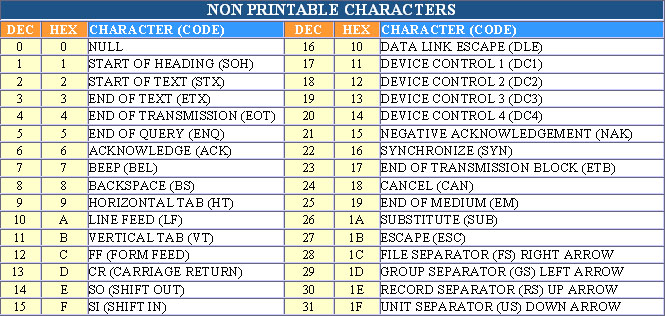In today’s digital age, non-printable characters have become an integral part of our documents and online communication. These characters, although invisible to the naked eye, play a crucial role in formatting and encoding information. Understanding and managing non-printable characters is essential, especially for professionals working with documents, spreadsheets, and coding. Let’s explore the significance of non-printable characters and how they can be effectively managed.
Non-Printable Characters: What are they?
Non-printable characters are special characters that are not visible when printed or displayed on a screen. They are typically used for various purposes such as formatting, controlling text flow, indicating line breaks, or denoting special instructions. These characters include spaces, tabs, line breaks, carriage returns, and other control characters that are not meant to be seen in the final output.
 One might wonder, “If these characters are not visible, why should I be concerned about them?” Well, understanding non-printable characters is crucial for several reasons:
One might wonder, “If these characters are not visible, why should I be concerned about them?” Well, understanding non-printable characters is crucial for several reasons:
- Document Accuracy and Consistency
Non-printable characters can sometimes sneak into documents when copying and pasting content from different sources. These hidden characters can disrupt the flow and formatting of the text, resulting in inconsistencies. Properly identifying and removing these characters ensures that the document remains accurate and consistent.
 2. Coding and Programming
2. Coding and Programming
For programmers and developers, non-printable characters play a crucial role in coding and scripting. These characters are used to define control sequences, escape characters, and special commands. Understanding and correctly implementing these characters is essential for ensuring the functionality and accuracy of the code.
 3. Data Integrity and Cleanliness
3. Data Integrity and Cleanliness
Non-printable characters can also affect the integrity and cleanliness of data. In databases and spreadsheets, these characters may cause issues when sorting, filtering, or performing calculations. Removing non-printable characters ensures that the data remains accurate and easily readable.
 Managing Non-Printable Characters
Managing Non-Printable Characters
Now that we understand the significance of non-printable characters, let’s explore some ways to manage them effectively:
- Showing Non-Printing Characters
Most word processors and text editors offer an option to display non-printable characters. By enabling this feature, you can easily identify and manage these characters in your document. Google Docs, for example, allows users to enable the display of non-printable characters, making it easier to spot hidden formatting elements.
 2. Removing Non-Printable Characters
2. Removing Non-Printable Characters
There are several tools and functions available to remove non-printable characters from documents. In programming languages like Java, you can use functions to filter out these characters from strings. Similarly, in Excel, the CLEAN function can be used to remove non-printable characters from cell values.
 3. Regular Expressions
3. Regular Expressions
For advanced users and programmers, regular expressions can be a powerful tool for managing non-printable characters. Regular expressions allow you to define patterns and search for specific characters or character ranges, making it easier to manipulate and remove non-printable characters.
 Conclusion
Conclusion
Non-printable characters may not be visible, but they have a significant impact on the accuracy, consistency, and cleanliness of our documents and data. Understanding how to manage these characters effectively ensures that our documents and code remain error-free and easily readable. Whether you’re a writer, programmer, or data analyst, taking the time to understand and address non-printable characters will undoubtedly improve your work and enhance the quality of your final outputs.
Image Sources:
2. How to Show Non-Printing Characters in Google Docs